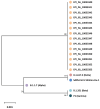From Entry to Outbreak in a High School Setting: Clinical and Wastewater Surveillance of a Rare SARS-CoV-2 Variant
- PMID: 40284920
- PMCID: PMC12030855
- DOI: 10.3390/v17040477
From Entry to Outbreak in a High School Setting: Clinical and Wastewater Surveillance of a Rare SARS-CoV-2 Variant
Abstract
In December 2021, an outbreak of the SARS-CoV-2 B.1.640.2 variant, potentially originating from Cameroon, was investigated among schoolchildren in Germany. The index case, an adult who had recently returned from a three-week stay in the Republic of Congo, introduced the variant into a school setting via their children, resulting in subsequent transmission within the school and ultimately to a hospital ward. Whole-genome sequencing of viral samples identified both B.1.640.1 and B.1.640.2 lineages. This outbreak highlights the unpredictable nature of emerging SARS-CoV-2 variants and emphasizes the importance of early detection and containment to mitigate transmission to high-risk populations. Notably, wastewater surveillance detected the variant during the study peri-od, reinforcing the utility of wastewater-based epidemiology as a complementary tool for the early warning and containment of novel variants. These findings underline the critical need for timely research and adherence to quarantine measures to enhance outbreak control efforts.
Keywords: SARS-CoV-2; outbreak investigation; wastewater.
Conflict of interest statement
The authors declare no conflicts of interest. OEA wishes to declare that she is currently working for the company Pfizer Hellas S.A. and that the content of the publication does not reflect Pfizer’s position.
Figures




Similar articles
-
Combining analysis of individual and wastewater whole genome sequencing improves SARS-CoV-2 surveillance.Water Res. 2025 Sep 15;284:123953. doi: 10.1016/j.watres.2025.123953. Epub 2025 Jun 3. Water Res. 2025. PMID: 40516408
-
SARS-CoV-2 surveillance of wastewater in small rural communities identifies lack of vaccine coverage as influence of omicron outbreak.Water Res. 2025 Sep 1;283:123818. doi: 10.1016/j.watres.2025.123818. Epub 2025 May 12. Water Res. 2025. PMID: 40381278
-
Utilizing Whole Genome Sequencing to Investigate a COVID-19 Cluster Among Healthcare Workers in a Tertiary Care Facility in the Philippines: Insights and Implications for Infection Prevention and Control.Clin Infect Dis. 2025 Jul 18;80(6):1262-1268. doi: 10.1093/cid/ciaf057. Clin Infect Dis. 2025. PMID: 40590532 Free PMC article.
-
Measures implemented in the school setting to contain the COVID-19 pandemic.Cochrane Database Syst Rev. 2022 Jan 17;1(1):CD015029. doi: 10.1002/14651858.CD015029. Cochrane Database Syst Rev. 2022. Update in: Cochrane Database Syst Rev. 2024 May 2;5:CD015029. doi: 10.1002/14651858.CD015029.pub2. PMID: 35037252 Free PMC article. Updated.
-
Unintended consequences of measures implemented in the school setting to contain the COVID-19 pandemic: a scoping review.Cochrane Database Syst Rev. 2024 Dec 12;12(12):CD015397. doi: 10.1002/14651858.CD015397.pub2. Cochrane Database Syst Rev. 2024. PMID: 39665337
References
-
- Butt A.A., Dargham S.R., Chemaitelly H., Al Khal A., Tang P., Hasan M.R., Coyle P.V., Thomas A.G., Borham A.M., Concepcion E.G., et al. Severity of Illness in Persons Infected With the SARS-CoV-2 Delta Variant vs Beta Variant in Qatar. JAMA Intern. Med. 2022;182:197–205. doi: 10.1001/jamainternmed.2021.7949. - DOI - PMC - PubMed
-
- Winkel A., Kozanli E., Haverkort M.E., Euser S.M., Sluiter-Post J.G.C., Mariman R., Vogelzang A., de Bakker J., Lap C.R., van Houten M.A., et al. Lower levels of household transmission of SARS-CoV-2 VOC Omicron compared to Wild-type: An interplay between transmissibility and immune status. J. Infect. Dis. 2024;231:653–664. doi: 10.1093/infdis/jiae546. - DOI - PubMed
-
- Nyberg T., Ferguson N.M., Nash S.G., Webster H.H., Flaxman S., Andrews N., Hinsley W., Bernal J.L., Kall M., Bhatt S., et al. Comparative analysis of the risks of hospitalisation and death associated with SARS-CoV-2 omicron (B.1.1.529) and delta (B.1.617.2) variants in England: A cohort study. Lancet. 2022;399:1303–1312. doi: 10.1016/S0140-6736(22)00462-7. - DOI - PMC - PubMed
MeSH terms
Substances
Supplementary concepts
LinkOut - more resources
Full Text Sources
Medical
Miscellaneous

